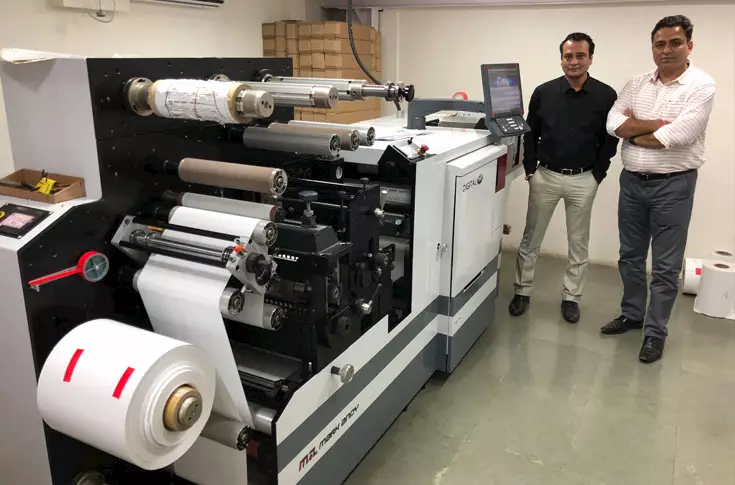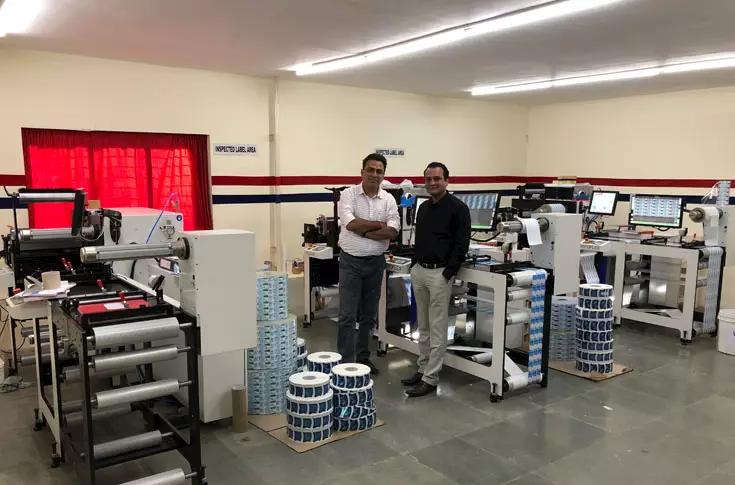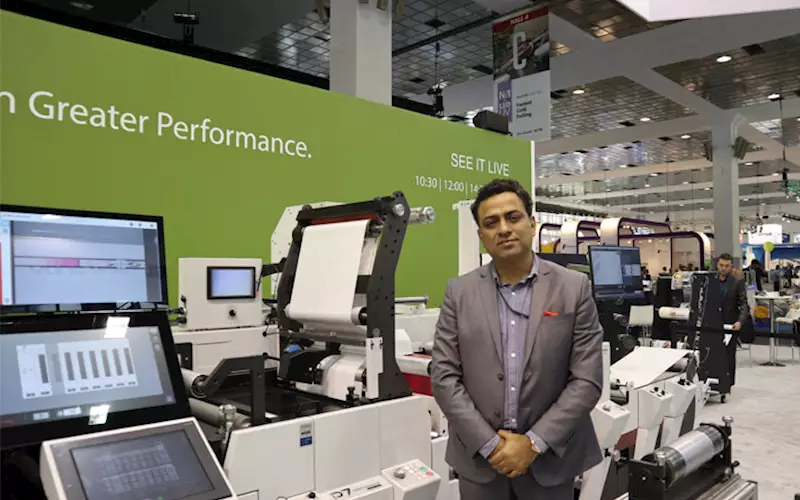Digital One: End-to-end in one go
Having installed the Mark Andy Digital One at Barcom, FIG is now officially in the digital label segment. Gourav Roy, managing director, FIG, explains to Rahul Kumar the reality of the digital label segment in India
24 Jul 2018 | By Rahul Kumar
Gourav Roy, managing director of Delhi-based Flexo Image Graphics (FIG), which, among other brands, represents Mark Andy in India, is a happy man these days. Recently, the company sold its first Mark Andy Digital One to Mumbai-based Barcom Industries. This also happens to be the first installation of the machine in Asia, joining over 80 others in production since the digital label press was introduced at Labelexpo Americas in 2016.
Barcom Industries, meanwhile, has been a Mark Andy loyalist since it started with a pre-owned Mark Andy 830 press in 2002. The company today operates several Mark Andy Performance Series P5 presses. Now, they begin their digital journey with the Digital One.
A digital label press designed to free up capacity on high output flexo presses, and to bring greater efficiency to fast turnaround, Digital One was born after the Mark Andy development team sat down and interviewed 147 customers and asked them what it would take to create a practical digital label press for the everyday converter. It found that the typical converter needed something affordable to buy, dependable to run, and profitable to operate. In the end, the company developed a configuration that has been proven to support over 80% of prime label applications. And it has proven to be a successful product from Mark Andy’s stable in less than two years.
In short, the success of Digital One reflects the current market condition. Today, run lengths are shrinking and competition is increasing. At the same time, print quality is crucial, and customers require shorter lead times. Digital One offers a practical solution.

Mumbai’s Barcom Industries became the first Indian firm to invest in Mark Andy Digital One
This is what attracted Barcom to Digital One. Prasanna Sahu, chairman of Barcom Industries, says, “We opted for the machine for its ease of operation, quality output, and fast production.” Now, Sahu adds, he can deliver finished products to customers in short span of time. “This is because digital printing eliminates several processes such as the need of making plates, registration, colour matching, reduces wastage, time, and requires less labour,” he says.
Mark Andy in India
According to Roy, Mark Andy has around 55% of market share in India in printing presses, with major installations in companies like Zircon Technologies, Jain Transfers, Encana International in Baddi, Wonderpack, and A&S Labels, among others.
“Given the ever-changing demands, we’re seeing loyal Mark Andy customers looking to remain competitive by upgrading existing flexo equipment with the award-winning Performance Series platform,” Roy says. “This is attractive for converters due to the limitless configurations, offering a truly future-proof solution.”
Selling digital
Traditionally Mark Andy has been a leader in narrow-web flexo. The same way, FIG, so far, has been operating in the flexo label market. Beside Mark Andy, the company represents brands like Rotoflex, Multipress and Stanford, among others. With the installation of the Digital One, however, FIG has officially ventured into the digital label segment.
Digital label presses are still a new concept for Indian label converters. They recognise the need for it. The demand for short-run labels is all too real and digital printing is a better solution. But the cost of a digital label press is still prohibitive for most label converters.
Plus, there are options to choose from, with brands like HP and Xeikon in the fray. In this, what is FIG’s game plan in selling digital label presses?
“In our case, we are not selling digital printing presses alone. One of the challenges is finishing and completing the job in one go. Multiple print enhanced solutions are not provided by standalone digital printing presses manufacturers. You need to buy additional equipment,” says Roy. “From Mark Andy’s perspective, we focus to finish the entire job in one pass. It is a combination of flexo with digital, delivering sellable product right off a single press.”
According to Roy, volume is another important area. “Standalone digital printing presses are slower than hybrid printing presses. With Mark Andy’s portfolio of hybrid solutions, production of 50,000 to 1,00,000 labels on digital is achievable and profitable, not just 5,000 or fewer labels. In this case, speed is also favorable. So ours is a different technology compared to standalone digital technology,” he adds.
Again, Digital One is a dry toner concept targeted at entry-level digital printing. Roy says Mark Andy has designed the machine keeping in mind that everything must be finished in one pass. “In Digital One, we can offer varnishing and cold foiling stations. It’s a combination of print finishing and print enhancement. Slitting is also achieved in a single pass. There is no need to buy any additional equipment. This is an advantage because with standalone digital presses, you need additional equipment. It increases the variables and thus investment,” he explains.
Finding customers
Roy believes that there is awareness about digital/ hybrid presses. “The mindset is changing slowly. Label converts are ready to understand the value of digital,” he says. “And with Mark Andy hybrid, we’re allowing converters to transform what they know with flexo printing while reaping the benefits of digital printing.”
Yet, Roy believes, the market is still in the nascent stage and it will take another few years to realise that digital is a must. “I am talking about multi-colour printing. About 90% convertors are looking at inkjet solutions for 2D and 3D bar codes. Monochrome digital is becoming very popular nowadays. For multi-colour, it will take time, but the time will come for sure. We will see something about it at Labelexpo 2019.”
Digital showcase at labelexpo
Talking about Labelexpo Brussels, what has been the representation of digital at the premier show over the years and how has Indian converters reacted to it?
Roy says in 2015, there was a definite buzz of digital printing but in Labelexpo 2017, manufacturers demonstrated solutions which have been accepted by the market. “In 2015, they were talking only about very developed markets, but in 2017, they were looking at developing and emerging markets,” he explains.
Yet, Roy reiterates that printers are still apprehensive. “They are starting to understand the benefits of it. Butare still looking at cost per label or sq/cm cost of labels,” he says.
At the same time, Roy believes converters have come to understand the overall cost of running the business. “When we talk about long changing time, turnaround time and others, digital printing makes sense. We are prepared to help our customers experience these benefits,” he adds.
Cost vs benefits
Besides the concern about the cost per label, another major concern is the cost of investment. In this context, how can a manufacturer or supplier convince a customer?
Roy shares there is an extensive portfolio of solutions tailored to any size business, all of which are backed by local support. “I personally believe a support system is the most important aspect, even more so with advanced technology. After-sales service is an area with ample possibilities and it’s important and crucial too. It is not about selling machines anymore. It’s not just about the cost of the machine. There are people who understand this,” he adds.
Roy said today, FIG has around 50 preventive maintenance contracts all over India for Mark Andy and Rotoflex machines. The company has 37 people, 12 of which are service engineers and they are located in all major cities in India. They are experienced and certified by Mark Andy technical team. “Service is our backbone. If we can sustain that, if we can improve upon it, we can enhance the quality of services then market is growing. More requirements will come as far as equipment is concerned,” he says.
Digital label presses, especially hybrid label presses, is a new concept in the market. Here, from pre-press to printing, everything is different. For this, we need trained operators. This is another area of concern for converters investing in a new technology.
Roy says the company offers thorough training at the customers’ site for operation. “Whoever buys a Mark Andy press, whether that be a flexographic Performance Series or Digital One hybrid, we offer free of cost to send three people to Mark Andy University in St Louis, USA. The course varies from seven to 15 days. We are also ready for hands-on training,” he says.
Up next, FIG will be at Labelexpo India in November 2018.

The Digital One has been designed to free up capacity on high output flexo presses














 See All
See All